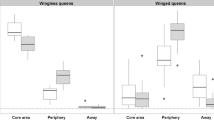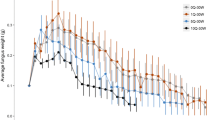Abstract
Nest-founding queens of social insects typically experience high mortality rates. Mortality is particularly severe in leafcutter ants of the fungus-growing ant genus Atta that face the challenge of cultivating a delicate fungus garden in addition to raising brood. We quantified foundress queen survivorship of Atta texana that were collected in northwest Texas and maintained in single-queen laboratory nests, and we tracked the rate of colony growth during the first precarious months of the colony lifecycle. Ninety days post-mating flight, only 16.3 % of 141 of the original queens had survived, and colony growth rates varied markedly across the surviving colonies. Worker production was weakly correlated with fungus garden growth over the course of early colony development. Dead queens became overgrown by the parasitic fungi Fusarium oxysporum (26 % of dead queens) and Aspergillus flavus (34 %), and these fungi are therefore possible causes of queen mortality. The phorid fly Megaselia scalaris emerged from one dead queen, but was unlikely the cause of death. Under natural conditions, intense competition between conspecific colonies can amplify small differences in initial growth rates to generate drastic differences in colony fitness. The observed variation in colony growth rate therefore suggests that colony growth is likely an important target for selection to optimize fitness in Atta texana.


Similar content being viewed by others
References
Augustin JO, Santos JFL, Elliot SL (2011) A behavioral repertoire of Atta sexdens (Hymenoptera, Formicidae) queens during the claustral founding and ergonomic stages. Insect Soc 58:197–206
Autuori M (1942) Contribuição para o conhecimento da saúva (Atta spp. -Hymenoptera -Formicidae) II. O saúveria inicial (Atta sexdens rubropilosa Forel, 1908). Arq Inst Biol 13:67–86
Autuori M (1950) Contribuição para o conhecimento da saúva (Atta spp. -Hymenoptera -Formicidae) V. Numero de formas aladas e redução dos saúverios iniciais (Atta sexdens rubropilosa Forel, 1908). Arq Inst Biol 19:325–331
Borgmeier T (1928) Nota previa sobre alguns phorideos que parasitam formigas cortadeiras dos gêneros Atta e Acromyrmex. Bot Biol 14:119–126
Borgmeier T (1931) Sobre alguns phorideos que parasitam a saúva e outras formigas cortadeiras (Diptera: Phoridae). Arq Inst Biol 4:209–228
Boucias DG, Pendland JC (1998) Principles of insect pathology. Kluwer Academic Publishers, Dordrecht
Brian MV (1965) Social insect populations. Academic Press, New York
Brown BV (1997) Revision of the Apocephalus attophilus group of ant-decapitating flies (Diptera: Phoridae). Contr Sci 468:1–60
Cahan S, Julian GE (1999) Fitness consequences of cooperative colony founding in the desert leaf-cutter ant Acromyrmex versicolor. Behav Ecol 10:585–591
Clark RM, Fewell JH (2014) Transitioning from unstable to stable colony growth in the desert leafcutter ant Acromyrmex versicolor. Behav Ecol Sociobiol 68:163–171
Cole BJ (2009) The ecological setting of social evolution: The demography of ant populations. In: Gadau J, Fewell JH (eds) Organization of insect societies: from genome to sociocomplexity. Harvard University Press, Cambridge, pp 74–104
Currie CR, Mueller UG, Malloch D (1999) The agricultural pathology of ant fungus gardens. Proc Natl Acad Sci 96:7998–8002
Disney RHL (2008) Natural history of the scuttle fly, Megaselia scalaris. Annu Rev Entomol 53:39–60
Disney RHL, Elizalde L, Folgarait PJ (2008) New species and records of scuttle flies (Diptera: Phoridae) associated with leaf-cutter ants and army ants (Hymenoptera: Formicidae) in Argentina. Sociobiology 51:95–117
Disney RHL, Elizalde L, Folgarait PJ (2009) New species and new records of scuttle flies (Diptera: Phoridae) that parasitize leaf-cutter and army ants (Hymenoptera: Formicidae). Sociobiol 54:601–632
Fernández-Marín H, Zimmerman JK, Wcislo WT (2004) Ecological traits and evolutionary sequence of nest establishment in fungus-growing ants (Hymenoptera, Formicidae, Attini). Biol J Linnean Soc 81:39–48
Fowler HG (1987) Colonization patterns of the leaf-cutting ant, Atta bisphaerica Forel: evidence for population regulation. J Appl Ent 104:102–105
Fowler HG, Robinson SW, Diehl J (1984) Effect of mature colony density on colonization and initial colony survivorship in Atta capiguara, a leaf-cutting ant. Biotropica 16:51–54
Fowler HG, Pereira-da-Silva V, Forti LC, Saes NB (1986) Population dynamics of leaf-cutting ants: A brief review. In: Lofgren CS, Vander Meer RK (eds) Fire ants and leaf-cutting ants: biology and management (studies in insect biology). Westview Press, Boulder, pp 123–145
Ho EKH, Frederickson ME (2014) Alate susceptibility in ants. Ecol Evol 4:4209–4219
Hughes WOH, Boomsma JJ (2004) Let your enemy do the work: within-host interactions between two fungal parasites of leaf-cutting ants. Proc R Soc Lond B (Suppl) 3:S104–S106
Jacoby M (1944) Observações e experiências sôbre Atta sexdens rubropilosa Forel visando facilitar seu combate. Bol Min Agric Rio 12:1–55
Mehdiabadi NJ, Hughes B, Mueller UG (2006) Cooperation, conflict, and coevolution in the attine ant-fungus symbiosis. Behav Ecol 17:291–296
Meirelles LA, Montoya QV, Solomon SE, Rodrigues A (2015) New light on the systematics of fungi associated with attine ant gardens and the description of Escovopsis kreiselii sp. nov. PLoS One 10:e011206i7
Mintzer AC (1987) Primary polygyny in the ant Atta texana: number and weight of females and colony foundation success in the laboratory. Insect Soc 34:108–117
Mintzer A, Vinson SB (1985) Cooperative colony foundation by females of the leafcutting ant Atta texana in the laboratory. J New York Entomol Soc 93:1047–1051
Moser JC (1967) Mating Activities of Atta texana (Hymenoptera, Formicidae). Insect Soc 14:295–312
Mueller UG, Scott JJ, Ishak HD, Cooper M, Rodrigues A (2010) Monoculture in leafcutter ant gardens. PLoS ONE 5:e12668
Mueller UG, Mikheyev AS, Solomon SE, Cooper M (2011a) Frontier mutualism: co-evolutionary patterns at the northern range limit of the leafcutter ant-fungus symbiosis. Proc R Soc Lond 278:3050–3059
Mueller UG, Mikheyev AS, Hong E, Sen R, Warren DL, Solomon SE, Ishak HD, Cooper M, Miller JL, Shaffer KA, Juenger TE (2011b) Evolution of cold-tolerant fungal symbionts permits winter fungiculture by leafcutter ants at the northern frontier of a tropical ant-fungus symbiosis. Proc Natl Acad Sci 108:4053–4056
O’Donnell K, Humber RA, Geiser D, Kang S, Park B, Robert V, Crous PW, Johnston PR, Aoki T, Rooney AP, Rehner SA (2012) Phylogenetic diversity of insectivorous fusaria inferred from multilocus DNA sequence data and their molecular identification via FUSARIUM-ID and Fusarium MLST. Mycology 104:427–445
Oster GF, Wilson EO (1978) Caste and ecology in the social insects. Princeton University Press, Princeton
Porter SD, Pesquero MA, Campiolo S, Fowler HG (1995) Growth and development of Pseudacteon phorid fly maggots (Diptera: Phoridae) in the heads of Solenopsis fire ant workers (Hymenoptera: Formicidae). Environ Entomol 24:475–479
R Core Team (2013) R: a language and environment for statistical computing. R Foundation for Statistical Computing, Vienna
Rehner SA (2012) Phylogenetic diversity of insectivorous fusaria inferred from multilocus DNA sequence data and their molecular identification via FUSARIUM-ID and Fusarium MLST. Mycol 104:427–445
Rissing SW, Pollock GB, Higgins MR, Hagen RH, Smith DR (1989) Foraging specialization without relatedness or dominance among co-founding ant queens. Nature 388:420–422
Rodrigues A, Pagnocca FC, Bacci M Jr, Hebling MJA, Bueno OC, Pfenning LH (2005) Variability of non-mutualistic filamentous fungi associated with Atta sexdens rubropilosa nests. Folia Microbiol 50:421–442
Rodrigues A, Bacci M, Mueller UG, Ortiz A, Pagnocca FC (2008) Microfungal “weeds” in the leafcutter ant symbiosis. Microb Ecol 56:604–614
Rodrigues A, Silva A, Bacci M, Forti LC, Pagnocca FC (2010) Filamentous fungi found on foundress queens of leaf-cutting ants (Hymenoptera: Formicidae). J Appl Entomol 134:342–345
Rodrigues A, Mueller UG, Ishak HD, Bacci M Jr, Pagnocca FC (2011a) Ecology of microfungal communities in gardens of fungus-growing ants (Hymenoptera: Formicidae): a year-long survey of three species of attine ants in Central Texas. FEMS Microbiol Ecol 78:244–255
Rodrigues A, Silva A, Bacci M Jr, Forti LC, Pagnocca FC (2011b) Filamentous fungi found on foundress queens of the leaf-cutting ants (Hymenoptera: Formicidae). J Appl Entomol 134:342–345
Seal JN, Mueller UG (2014) Instability of novel ant-fungal associations constrains horizontal exchange of fungal symbionts. Evol Ecol 28:157–176
Seal JN, Tschinkel WR (2007) Energetics of newly-mated queens and colony founding in the fungus-gardening ants Cyphomyrmex rimosus and Trachymyrmex septentrionalis (Hymenoptera: Formicidae). Physiol Entomol 32:8–15
Seal JN, Schiott M, Mueller UG (2014) Ant-fungus species combinations engineer physiological activity of fungus gardens. J Exp Biol 217:2540–2547
St. Leger RJ, Screen SE, Shams-Pirzadeh B (2000) Lack of host specialization in Aspergillus flavus. Appl Environ Microbiol 66:320–324
Weber NA (1972) Gardening ants, the attines. The American Philosophical Society, Philadelphia
Wilson EO (1971) The insect societies. Harvard University Press, Cambridge
Yek SH, Mueller UG (2011) The metapleural gland of ants. Biol Rev 91:201–224
Acknowledgments
We are grateful to M. Kardish and Z. Phillips for their assistance in data collection and ant care, and to S. Amador-Vargas, E. Dietrich, C. Fang, R. Ma, L. Meirelles, Z. Phillips, C. Smith and two anonymous reviewers for comments that greatly improved this manuscript. The study was funded by an Integrative Biology Fellowship to HEM, and National Science Foundation awards DEB-0919519 and DEB-1354666 to UGM.
Author information
Authors and Affiliations
Corresponding author
Rights and permissions
About this article
Cite this article
Marti, H.E., Carlson, A.L., Brown, B.V. et al. Foundress queen mortality and early colony growth of the leafcutter ant, Atta texana (Formicidae, Hymenoptera). Insect. Soc. 62, 357–363 (2015). https://doi.org/10.1007/s00040-015-0413-7
Received:
Revised:
Accepted:
Published:
Issue Date:
DOI: https://doi.org/10.1007/s00040-015-0413-7




